Last-Minute NYC Holiday Gift Guide 🎁
We’ve created a holiday gift guide with presents for the intrepid New Yorker that should arrive just in time—


Celebrate 2017’s Black History Month in New York City with a rich offering of culture, food, history and tours. You’ll find events in Harlem, Central Park, Riverside Church and even the Port Authority Bus Terminal. Here are 15 ways to celebrate Black History Month in New York City this February.
The photographer, Beuford Smith, was a founding member – and later served as president – of the group Kamoinge, a forum of African-American photographers with a focus on cultural roots. The new exhibit “Black Lives: Photographs by Beuford Smith” now on view at Keith de Lellis Gallery, features photographs from Smith’s career, taken in the turbulent 60s, documenting New York City from the tumultuous days after the assignation of Dr. Martin Luther King, Jr. to the heart of the jazz scene.
Black Lives: Photographs by Beuford Smith will be on view from February 9 to March 25. Keith de Lellis Gallery is located at 1045 Madison Avenue, #3 at 80th Street.
Did you know that during the period we think of as the Old West, one in four U.S. cowboys was African-American? Expanding that narrative, the Studio Museum in Harlem’s exhibit Black Cowboy aims to overcome the historical omission of the long history African-American communities have held in the keeping and training of horses. The exhibit, Black Cowboy, organized by Associate Curator, Amanda Hunt, features photographs and cinematic materials exploring the history of this tradition, and explores locations where this tradition is alive and well today. Black Cowboy will be on view at the Studio Museum in Harlem through March 5th.
While you’re there, check out Harlem Postcards, an ongoing program reflecting the culture of Harlem. Each of the four postcards is a limited edition, and free to visitors of the museum.
Follow the Studio Museum in Harlem outside the walls of the museum, in the installation, InHarlem, on view through July 25, 2017 in four Harlem parks.
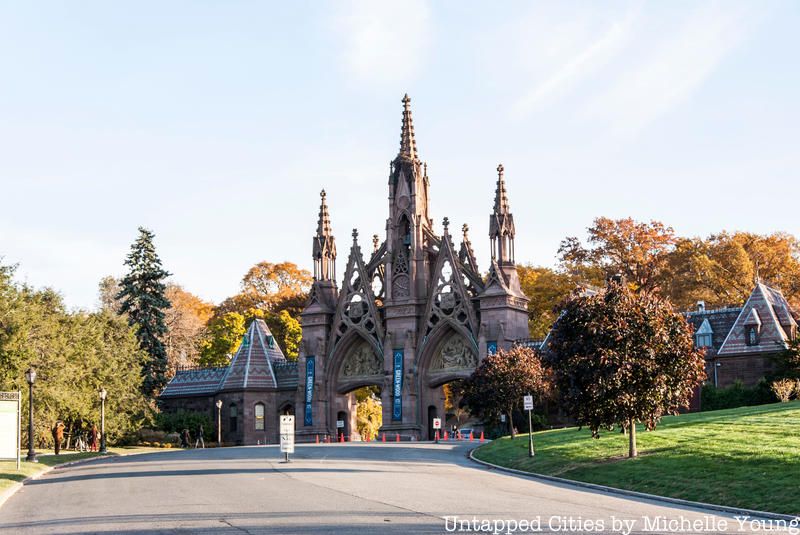
In 1838, a free black man by the name of James Weeks made his first purchase of land in Brooklyn. Today, Weeksville Heritage Center is Brooklyn’s largest African-American cultural institution and multidisciplinary museum dedicated to preserving the history of the 19th century African-American community of Weeksville. The Green-Wood Cemetery was also established in 1838, and is the home to the remains of many prominent African-Americans, who made their mark on the city’s past.
Green-Wood and Weeksville Heritage Center will celebrate Black History Month together, recognizing a shared history, on Saturday, February 25th. Green-Wood’s trolley will begin a tour of where many prominent Black New Yorkers and abolitionists are laid to rest, including Margaret Pine, the last woman to have lived as a slave in New York, Susan Smith McKinney Steward, whose family owned land in Weeksville, and who became the first black female doctor in the state, and the artist Jean-Michel Basquiat, among many others. The trolley will then head to Weeksville in Crown Heights to see the new permanent exhibition, “Weeksville, Transforming Community/In Pursuit of Freedom and the 19th century Hunterfly Road Houses.” The ADA accessible tour will begin and end at Green-Wood, and includes a box lunch.
Green-Wood Cemetery is located at 500 25th Street in Brooklyn.
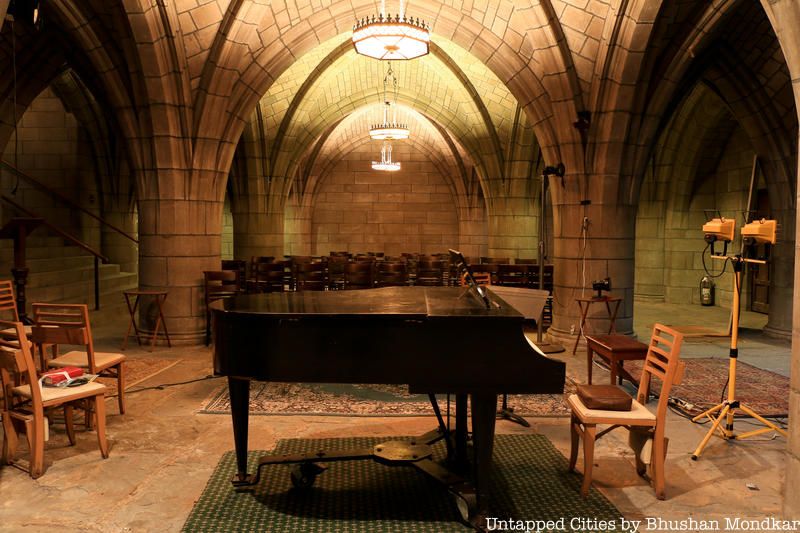
Celebrating the start of Black History Month, the Crypt Sessions at the Church of the Intercession in Harlem will hold a concert on February 1st, with classical pianist Lara Downes performing music by Duke Ellington, Billie Holiday, Florence Price, Nina Simone, and many more. There will also be a world premiere by composer/violinist Daniel Bernard Roumain, and a spoken world tribute to Langston Hughes, who would have celebrated his 115th birthday on that day.
A pre-concert reception will feature a tasting of Mouton Noir wine by Harlem-based producer, Andre Mack, with paired hors d’oeuvres. The Crypt Sessions is located at Crypt Chapel of the Church of the Intercession, 550 West 155th Street in Harlem.
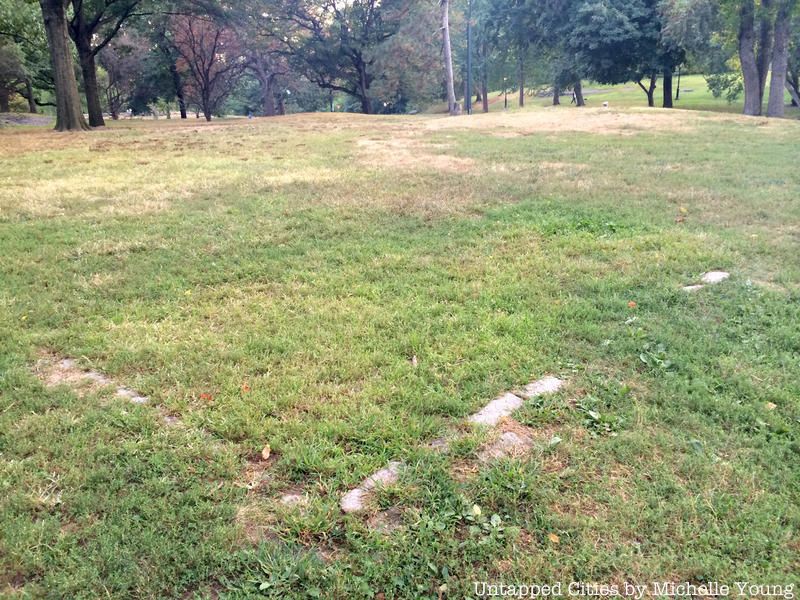
Central Park was once home to a thriving village made up mostly of African-American’s. Named Seneca Village, it was a middle-class town with “three churches, wood houses on assigned lots, a natural spring, basement schools, and a population of over 260.” It was a place where black residents owned their own land. In 1853, the city authorized the take-over of the land, and paid the settlers off. By 1857, when Central Park was officially opened, the settlement was gone.
Central Park Conservancy will offer two tours of what once was Seneca Village, during the month of February. On the tours, view where important residences and churches once stood before the park development, and learn about how life was for the Seneca Village residents in the 1800s.
The Louis Armstrong House and Museum is a place where visitors can have an intimate look at the man himself. This was the place he returned to, in between a year of about 300 concerts. The house, which was decorated by Armstrong’s wife, Lucille, has changed very little over the years. Now a museum, it holds several collections of photographs, sound recordings, letters and instruments. It is, in fact, the largest publicly held archival collection devoted to a jazz musician. The Louis Armstrong House Museum was designated a National Historic Landmark in 1976, and a New York City Landmark in 1988. After the passing of Lucille Armstrong in 1983, the Louis Armstrong Educational Foundation gave the house to the Department of Cultural Affairs, arranged for Queens College to operate it, and gifted Armstrong’s personal collection to Queens College. The museum opened to the public in 2003. The Louis Armstrong House Museum is located at 34-56 107th Street in Corona, Queens. Check their website for guided 40-minute tours.
The Center for Architecture will host the exhibitions, Say It Loud, featuring distinguished designers of color in the New York Chapter of the National Organization of Minority Architect’s (NYCOBA NOMA), along with winners of the Jumaane Omar Stewart Award for New York City high school students and the NYCOBA NOMA Diversity in the School of Architecture Award. The exhibition will feature projects by the 20 designers, as well as quotes and video interviews on their experiences in the architecture and design professions.
Say It Loud: Distinguished Black Designers of NYCOBA NOBA hopes to highlight the fact that approximately 2,090 licensed African-American architects in the United States represent only 2% of the total population of the country’s licensed architects, and the lack of recognition these individuals receive for their achievements.
Say It Loud is curated by Pascale Sablan. The exhibition will be on view to April 1, 2017 at the Center for Architecture, 536 LaGuardia Place.
In honor of Black History Month, Community Works and The Interchurch Center present a celebration entitled, Harlem is…..Music. The month-long celebration will include a full calendar of gallery talks and music, along side the exhibit, Harlem’s Black & Jewish Music Culture (1890-1930), sheet-music from that era that tells the story of collaborations between the neighborhood’s black and Jewish composers, performers, and music publishers. The archival materials and documents were created by Harlem historian and Columbia University Community Scholar, John Reddick. The celebration and exhibit will run through February 22nd, located at The Interchurch Center, 475 Riverside Drive at 120th Street & Claremont Avenue
Exploring themes of culture, spirituality, historical events, and icons, Harlem Needle Arts has curated an exhibit in textile and fiber arts for Black History Month. The group show, entitled The Rhythmic Art of Thread, features work in quilting, appliqué, mixed media, screening, fabric collage, and fiber fusion. The exhibit brings together eight well-known fiber artists, along with the 2016 Teen Curators of The Schomburg Center for Research in Black Culture, a program sponsored by the New York Public Library.
The Rhythmic Art of Thread is a free exhibit, and will be on view through February 24th at The Arsenal Gallery in Central Park, 830 Fifth Avenue at 64th Street
Taste Harlem Food and Culture Tours is a great way to sample a variety of African cuisines. From chicken & waffles to mac & cheese, and from the new Restaurant Rows on Lenox Avenue and Frederick Douglass Boulevard, to the private local haunts, this is a chance to explore not only the foods, but also the rich history and architecture of Harlem by a Harlem-based tour company that has been taking guests on tours since 2002.
Welcome to Harlem Tours has been located at 2360 Frederick Douglass Boulevard since 2004. The owner and tour guides were all born and raised in Harlem, and are a plethora of information on their daily walking tours through the historic district, with its elegant rows of brownstones, and historic churches. They will take you to iconic jazz clubs, or private haunts reminiscent of the 1920s Rent Parties. Attend gospel choirs, and visit African art galleries, markets and shops. Explore the architecture on historic streets like Strivers Row and Astor Row. Visit the historic murals, graffiti, and mosaics. Lots of tours to choose from during Black History Month.
B.B. King Blues Club will host the world-famous Harlem Gospel Choir for a Gospel Brunch four times in the month of February. The choir was founded in 1986 by Allen Bailey, after he attended a celebration in honor of Dr. Martin Luther King, Jr. at the Cotton Club in Harlem. He was so inspired by the music, that he went in search of the finest singers and musicians in Harlem’s Black Churches. The Harlem Gospel Choir performs regularly at B.B. Kings, and during Black History Month, there will be a Harlem Gospel Brunch Buffet on February 5, 12, 19 and 26th. B.B. King Blues Club is located at 237 West 42nd Street.
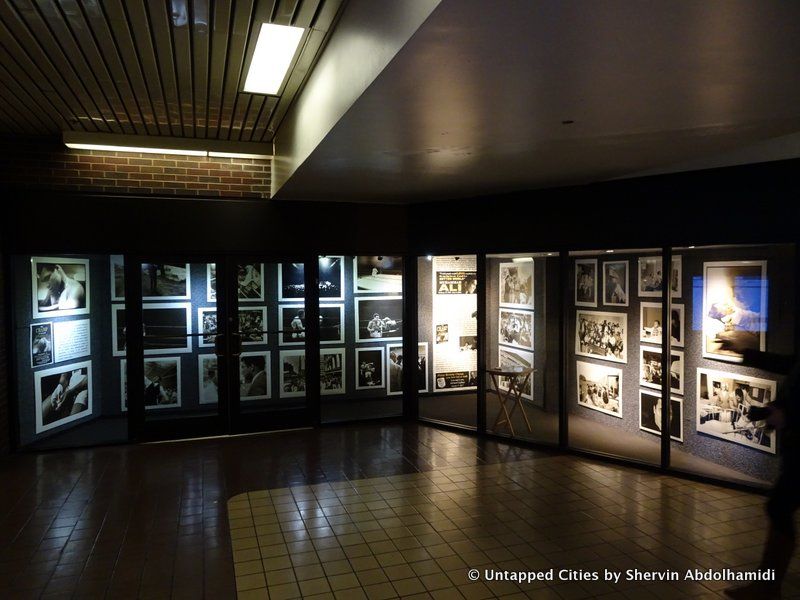
A Muhammad Ali photo exhibit is currently on view at the Port Authority Bus Terminal Gallery, curated by The Donna Compton Gallery. The exhibit features 64 photographs from the book “The Champ: My Year With Muhammad Ali” by photographer Michael Gaffney, who was the boxer’s personal photographer between 1977 and 1978. Timed for Black History Month, and Muhammad Ali’s birthday, the exhibit shows him as not only a fighter, but also a family man, philanthropist and thinker. Many of the photos were taken with his children.
The Muhammad Ali photography exhibit will be on display until February 26 at the Port Authority Bus Terminal, at 40th Street and 8th Avenue, near the 9th Avenue entrance.
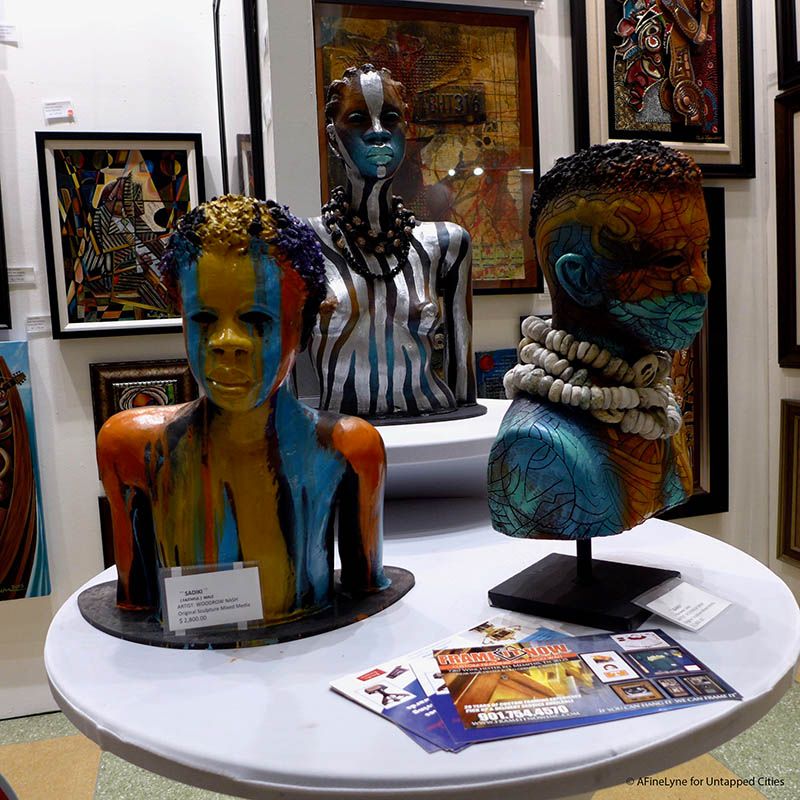
Harlem Fine Arts Show at historic Riverside Church, 2016
The Harlem Fine Arts Show is the largest traveling African Diaspora art show in the United States, exhibiting in Atlanta, Martha’s Vinyard, Washington D.C., the Bahamas, and in February, New York. The exhibit celebrates art of the African Diaspora, inspired by the Harlem Renaissance, and offers a platform for African-American visual artists to exhibit and sell their artwork.
The Harlem Fine Arts Show will be one view from February 16-19 in the historic Riverside Church, 91 Claremont Avenue, between 120th and 121st Streets. Check website for related events, including Gospel Brunch on Sunday, February 19th, with a salute to African-American Nurses.
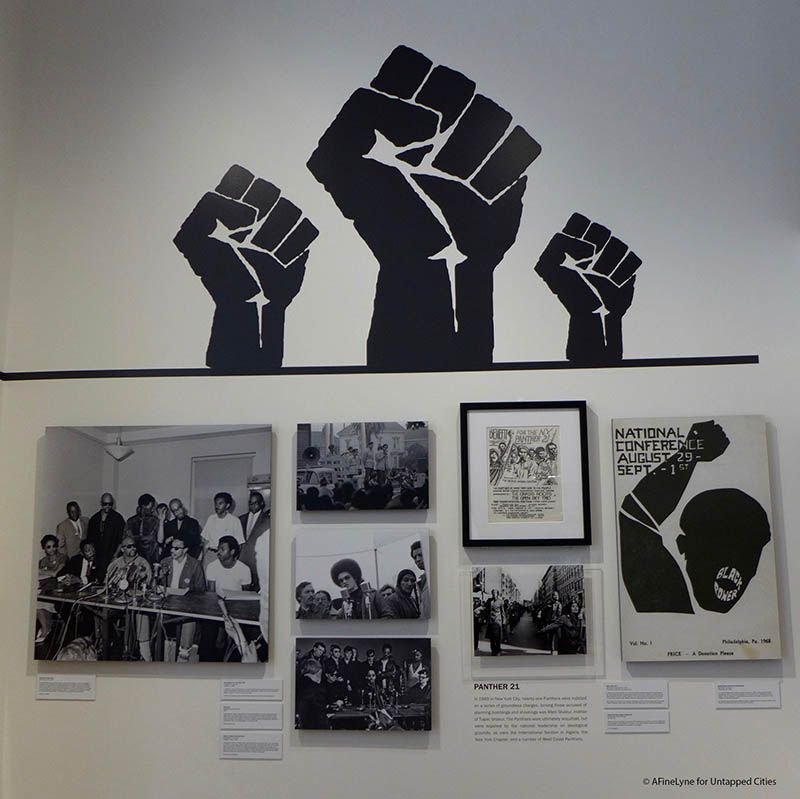
The Schomburg Center for Research in Black Culture has a host of activities, films, and talks during Black History Month, beginning with “Conversations in Black Freedom Studies: Black Power at 50” on February 2nd. Black History Month is a great way to introduce yourself to First Fridays at The Schomburg. The February 3rd First Friday will include the program, “Black Power Poetry Slam/Open Mic Edition.” Saturday, February 18, the Schomburg Center will host “Black Lives Matter Teen Conference,” and “Theater Talks: August Wilson Effect” on February 20.
These are just a few of what’s on tap at the Schomburg Center during Black History Month. The Schomburg Center for Research in Black Culture, a research unit of the New York Public Library, is located at 515 Malcolm X Boulevard (Lenox Avenue) at 135th Street.
Read about the Harlem African Burial Ground Memorial Project. Kerry James Marshall: Mastry is still on view at Met Breuer. Explore 21 Bakeries in Harlem, or try on a few Hats! Get in touch with the author at AFineLyne.
Subscribe to our newsletter